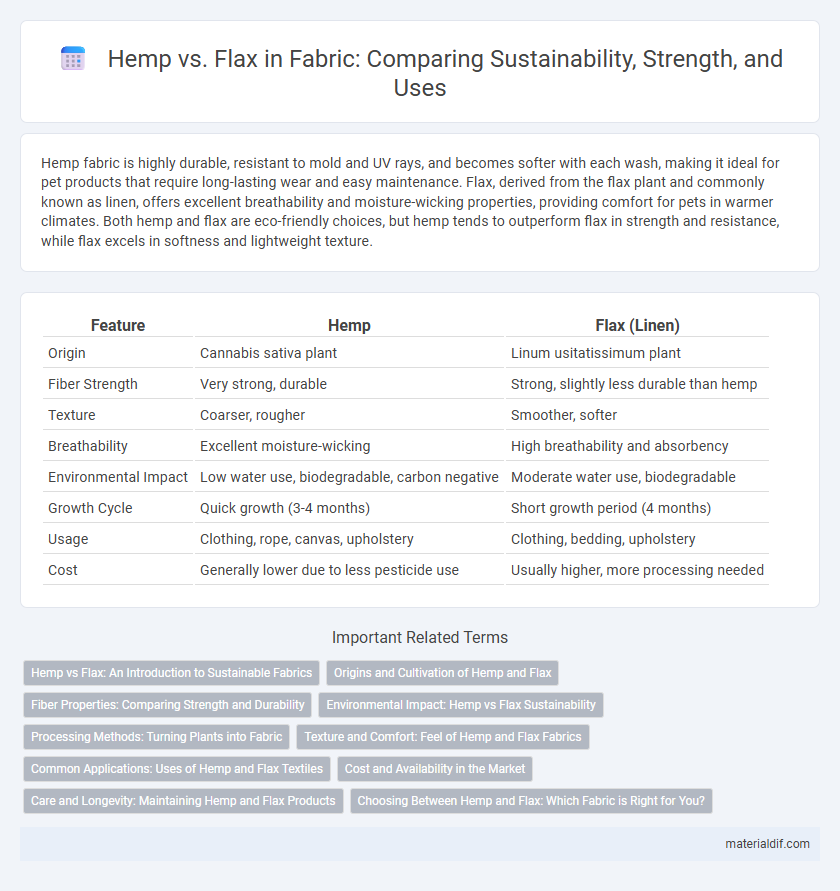Hemp fabric is highly durable, resistant to mold and UV rays, and becomes softer with each wash, making it ideal for pet products that require long-lasting wear and easy maintenance. Flax, derived from the flax plant and commonly known as linen, offers excellent breathability and moisture-wicking properties, providing comfort for pets in warmer climates. Both hemp and flax are eco-friendly choices, but hemp tends to outperform flax in strength and resistance, while flax excels in softness and lightweight texture.
Table of Comparison
| Feature | Hemp | Flax (Linen) |
|---|---|---|
| Origin | Cannabis sativa plant | Linum usitatissimum plant |
| Fiber Strength | Very strong, durable | Strong, slightly less durable than hemp |
| Texture | Coarser, rougher | Smoother, softer |
| Breathability | Excellent moisture-wicking | High breathability and absorbency |
| Environmental Impact | Low water use, biodegradable, carbon negative | Moderate water use, biodegradable |
| Growth Cycle | Quick growth (3-4 months) | Short growth period (4 months) |
| Usage | Clothing, rope, canvas, upholstery | Clothing, bedding, upholstery |
| Cost | Generally lower due to less pesticide use | Usually higher, more processing needed |
Hemp vs Flax: An Introduction to Sustainable Fabrics
Hemp fabric, derived from the fibers of the Cannabis sativa plant, offers exceptional durability, mold resistance, and requires minimal water and pesticides compared to conventional crops, making it a leading sustainable textile choice. Flax, the source of linen, is valued for its breathability, natural luster, and biodegradability, though it typically involves higher water usage and more intensive cultivation than hemp. Both hemp and flax epitomize eco-friendly fibers, with hemp excelling in resource efficiency and durability while flax is prized for its comfortable texture and historical significance in sustainable fabric production.
Origins and Cultivation of Hemp and Flax
Hemp originates from Central Asia and has been cultivated for over 10,000 years due to its adaptability and fast growth, thriving in diverse climates with minimal pesticides. Flax, native to the Mediterranean region, has been grown since ancient times primarily for its fine fibers and oil-rich seeds, favoring cooler, wetter conditions for optimal cultivation. Both plants contribute sustainable fabric options, but hemp's resilience and low resource requirements contrast with flax's demand for specific climatic conditions.
Fiber Properties: Comparing Strength and Durability
Hemp fibers exhibit exceptional tensile strength and durability, making them ideal for heavy-duty textiles and industrial fabrics. Flax fibers, while also strong, offer a finer texture and greater flexibility, suitable for lightweight and breathable fabrics. Both fibers are naturally resistant to wear and environmental stress, with hemp outperforming flax in long-term durability under harsh conditions.
Environmental Impact: Hemp vs Flax Sustainability
Hemp fabric demonstrates superior sustainability due to its rapid growth, requiring less water and fewer pesticides compared to flax, which typically demands more intensive cultivation practices. Hemp's deep roots enhance soil structure and prevent erosion, contributing to long-term soil health, whereas flax can deplete soil nutrients more quickly. Overall, hemp's lower resource inputs and benefits to soil ecosystems position it as a more environmentally friendly fiber choice than flax.
Processing Methods: Turning Plants into Fabric
Hemp fibers are extracted through a retting process that uses moisture and microbes to break down the plant's outer layers, followed by decortication to separate the bast fibers. Flax processing also involves retting but often employs water or dew retting to loosen fibers before scutching and hackling refine the flax fibers. Both plants require mechanical or chemical steps to transform raw stalks into long, strong fibers suitable for spinning into durable, eco-friendly fabrics.
Texture and Comfort: Feel of Hemp and Flax Fabrics
Hemp fabric features a coarse and sturdy texture that softens with use, offering exceptional breathability and moisture-wicking properties ideal for warm climates. Flax, the fiber behind linen, provides a smoother, lighter touch with a natural crispness that enhances comfort through its cool, breathable qualities. Both fibers excel in durability, but hemp's robust feel contrasts with flax's delicate softness, influencing the choice for tactile comfort in wearable textiles.
Common Applications: Uses of Hemp and Flax Textiles
Hemp textiles are widely used in sustainable fashion, upholstery, and industrial applications due to their durability and resistance to mold and UV light. Flax fibers, processed into linen, excel in lightweight clothing, home textiles, and luxury bed linens for their breathability and smooth texture. Both fibers are favored in eco-friendly markets, with hemp often chosen for rugged products and flax preferred for soft, high-end fabrics.
Cost and Availability in the Market
Hemp fabric typically costs more than flax due to its complex processing requirements and limited large-scale cultivation. Flax, the source of linen, benefits from widespread availability and established production channels, making it generally more affordable in the textile market. Market demand and regional growing conditions further influence the price fluctuations and accessibility of both hemp and flax fabrics.
Care and Longevity: Maintaining Hemp and Flax Products
Hemp fabrics require minimal maintenance due to their natural resistance to mold and UV light, making them highly durable and long-lasting with regular gentle washing and air drying. Flax fibers, used in linen, benefit from gentle hand washing or machine washing on a delicate cycle, maintaining strength and softness over time when kept away from direct sunlight during drying. Both materials age gracefully, with hemp becoming softer and more durable, while flax develops a natural patina that enhances its longevity.
Choosing Between Hemp and Flax: Which Fabric is Right for You?
Choosing between hemp and flax fabric depends on your priorities such as durability, eco-friendliness, and texture. Hemp fabric is highly durable, resistant to mold and ultraviolet light, and requires less water and pesticides compared to flax. Flax, derived from the flax plant, produces linen known for its softness and breathability, making it ideal for lightweight and comfortable clothing.
Hemp vs Flax Infographic

 materialdif.com
materialdif.com